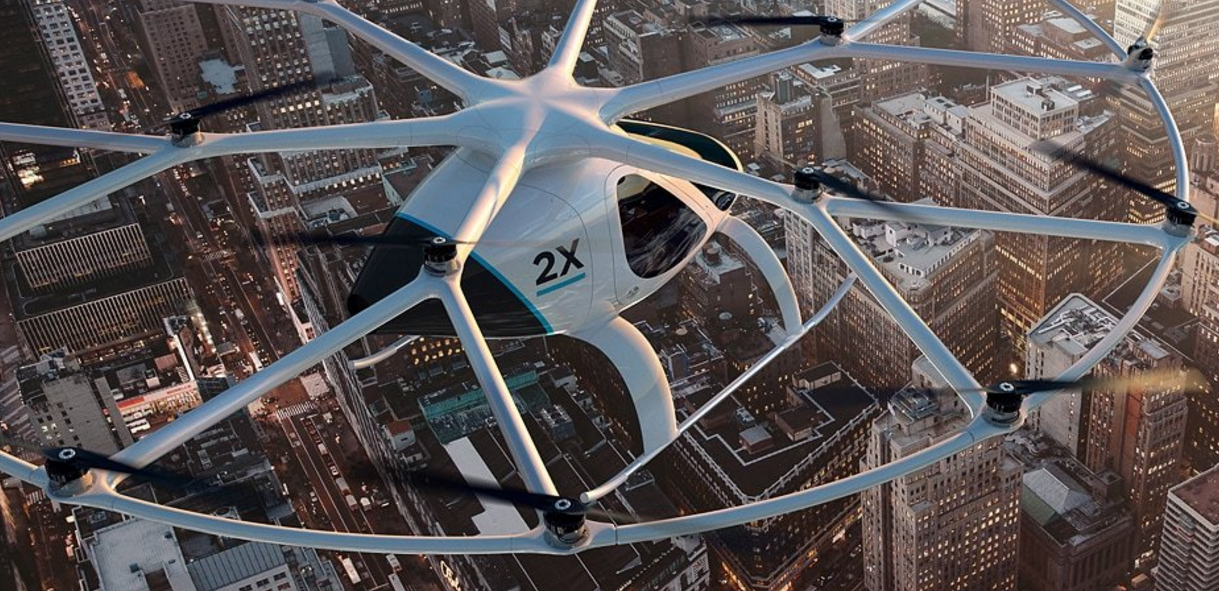Dubai begins testing drone taxi service


Dubai has announced the first test flight for its taxi drone, which saw the driverless flying transport service hover around 200 metres above the ground during a five-minute flight.
The taxi drone was designed by German company Volocopter, and resembles a two-seater helicopter topped by a hoop equipped with 18 propellers, designed for 30-minute flights at maximum.
The drone also comes with back-up batteries, rotors, and two parachutes in case of flight failures, and would involve building "voloports" from where passengers would embark and disembark the service.
The test flight took place as part of a ceremony for Dubai Crown Prince Sheikh Hamdan bin Mohammed. Following the trial, Volocopter CEO Florian Reuter said the company plans to launch the flying taxi service within five years.
"Implementation would see you using your smartphone, having an app, and ordering a volocopter to the next voloport near you. The volocopter would come and autonomously pick you up and take you to your destination," Reuter said.
"It already is capable of flying based on GPS tracks today, and we will implement full sense capability, also dealing with unknown obstacles on the way."
Dubai officials had in February announced plans to launch an autonomous drone passenger craft by July 2017.
Head of Dubai's Roads and Transportation Agency Mattar Al Tayer at the time said the EHang 184 drone -- introduced at the Consumer Electronics Show (CES) 2016 -- was undergoing test flights over the Burj al-Arab in Dubai.
The EHang 184 has a four-rotor design, and is capable of carrying up to 100kg, or one individual passenger with baggage. It is able to fly at a maximum of 100 miles an hour for 23 minutes at sea level, or 10 minutes at 62 miles an hour at a higher altitude.
Able to operate in an area of up to 50km, EHang originally announced plans to use the autonomous drone to transport organs with Lung Biotechnology last year.
Sheikh Mohammed bin Rashid Al Maktoum said last April that he envisions a quarter of all journeys to be driverless by 2030 in Dubai, with the UAE already using a driverless rail service transporting millions of passengers each year.
Middle Eastern company Careem will also begin testing its driverless electric pod vehicles in Dubai, it announced last month, as part of a collaboration with California-based NEXT Future Transportation.
Aircraft manufacturer Airbus is also working on its own flying taxi drone named Vahana, in May saying it should be commercially viable by 2020 depending on whether next-generation computing power has the ability to examine 4,000x3,000-pixel images from radar, lidar, and cameras and stitch them together to detect objects.
Vahana, which Airbus is hoping to test during 2017, is designed to travel at around 230km/h, Airbus A3 head of autonomous systems Arne Stoschek said, and will have to skirt airborne obstacles without the ability to apply brakes.
"If we have an obstacle 500 metres away ... that's 10 seconds to impact. If we have something that is [approaching] with our own speed, closing speed of 100 metres per second, then we have five seconds to impact, which is not a lot of time," Stoschek said at the time.
"So we need to be both very accurate, and very fast."
Airbus will need an order of magnitude increase in CPU performance, memory, power usage, software, and hardware to handle the sheer amount of data involved, Stoschek said, and there will also have to be an overhaul in drone regulations, he added.
"We have a set of rules for cars that allows cars to be operated basically bumper-to-bumper, so you can pack a ton of cars [in]," he said.
"Currently in aerospace it is very, very different ... you need to have what is called a separation distance, [such that] you could operate one aircraft over the entire city of San Francisco.
"So obviously in aerospace, we need a new system of rules that allows us to pack a lot of aircraft into the sky."
Telstra CTO Håkan Eriksson had last week suggested that regulatory difficulties could be solved by treating drones as flying mobile phones and allowing network operators to offer a "drone-control-as-a-service" offering.
"What if we say every drone is like a flying mobile phone? Put a SIM card in them so they have identity, put the radio in so they can always talk to them, and then if a drone wants to take off it has to talk to a database where we put all the rules," Eriksson said.
Requirements such as how many drones are allowed to fly in a given area, what height they are allowed to travel at, what hours they are permitted to fly during, and how close they are allowed to be within certain buildings or people could be programmed into this database, Eriksson said.
Concerns about drones getting in the way of aircraft would also be addressed via the use of mobile networks, Eriksson told ZDNet, because coverage only extends to around 150m above ground level.
"The most useful use of drones is up to say maybe 100 metres. There's no point -- if it cannot deliver something, search for somebody, there's no point flying much higher, because that's where you see things. So up to that height, we have pretty good coverage with the mobile network ... and there are no planes there," he explained.
With AAP